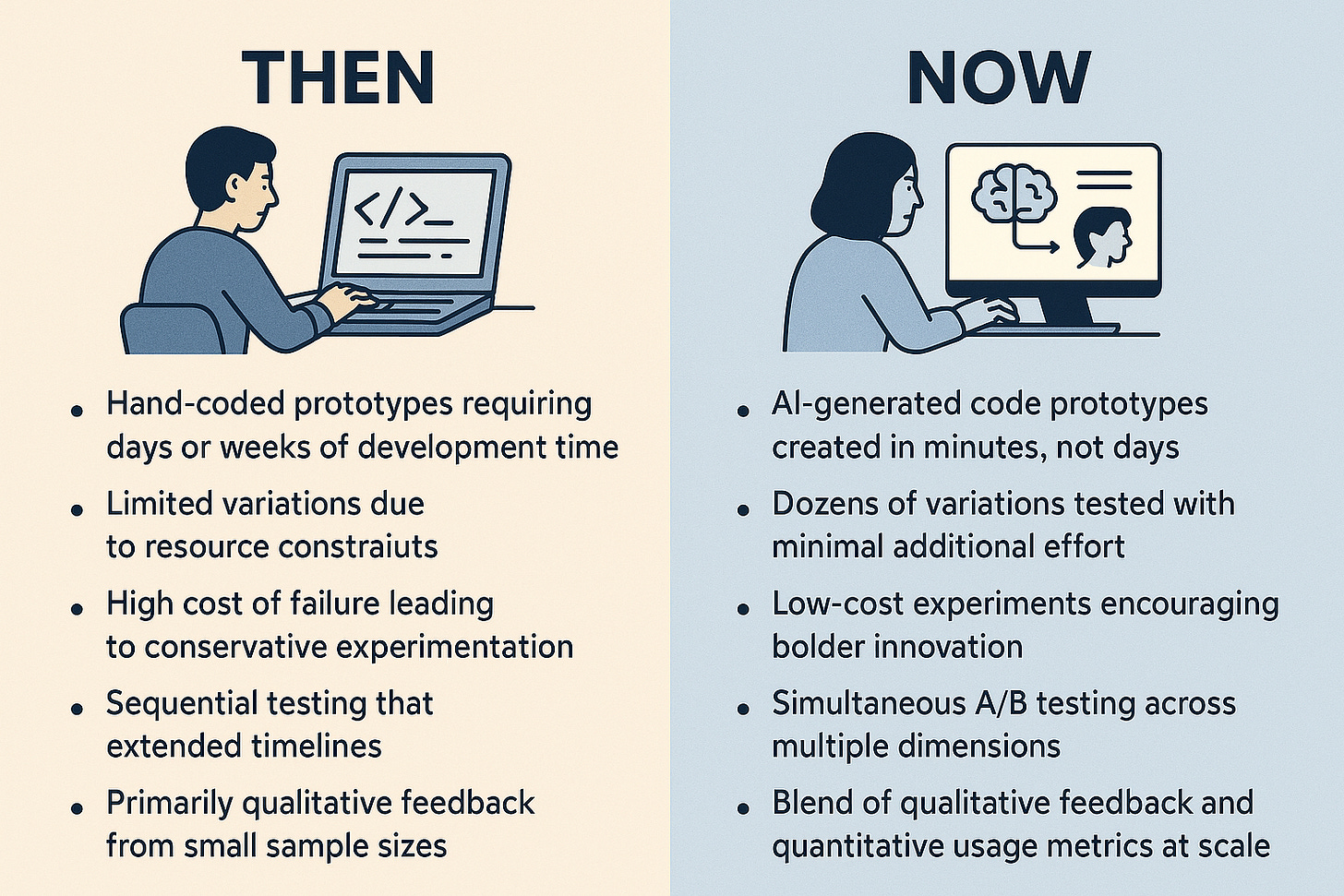Play, Probe, Pivot, Produce
Real reasons AI powered prototyping is such a big fucking deal
Hey, remember when we used to talk endlessly about building stuff?
How the hardest part was always knowing exactly what to build in the first place?
Turns out we were onto something big 😂.
Great products are born from clarity. But clarity itself comes from constantly toggling between understanding what's wrong (i.e. the problem space) and figuring out how to fix it (i.e. the solution space).
IMHO, the most profound and still very underestimated shifts is how AI-powered rapid prototyping makes moving between problem and solution space faster, clearer, and oh-so-much more potent.
Problem Space Probing
Its best to think about exploring the problem space as probing. It's not about finding immediate answers. Its about stirring up the right questions.
It's about figuring out why something is frustrating or hard. Not prematurely guessing how to solve it.
Then
Say you're wondering why developers ditch your observability product after toggling arcane filters for ten minutes.
You dove into user stories, sketched rough storyboards, or launched very small provocation as Wizard-of-Oz experiments like a simple button labeled "Daily Metrics" that doesn't even lead anywhere yet, just to see if people care enough to click.
Now
You prompt your way with a few real users on Zoom to a visually accurate pre-canned working dashboard on metric activity that is real and vivid. It then prompts the kind of feedback you need to answer: Does it resonate? Do you now know the prior source of frustration?
You get immediate clarity without investing tons of time or resources. Rapid prototyping with AI allows for newfound illumination.
Solution Space Testing
Then there's the solution space where rapid prototyping transforms from probing into testing.
You've defined your problem clearly, and now you're experimenting with solutions. Here, prototyping isn't about uncovering new problems it's about narrowing down your solutions with real-world data.
Then
Imagine you're trying to streamline a sales rep's chaotic daily schedule.
You mock up detailed interactive designs in Figma or spin up an A/B test comparing guided onboarding for your sales rep tool versus self-serve.
Now
You might prompt your way to two interactive prototypes:
One as a calendar grid.
Another as a straightforward task list.
Then you put them into users' hands in your actual product and watch closely. Do they effortlessly reschedule meetings in one layout and stumble in another?
That's your rapid AI prototype giving you clarity.
It tells you exactly how users behave when presented with concrete options, no guessing required.
The Beautiful Iterative Loop
We all claim to want to be Agile. But we’re really not. For the most part its still: design → develop → test. If anything being Agile just means for most waterfall on a shorter time cycle.
Lets walk through an example based on our scheduling tool we can all relate to…
Then
Month 1: Plan research about user scheduling problems
Month 2: Conduct interviews with 12 users
Month 3: Synthesize findings into requirements
Month 4: Design solution concepts
Month 5: Build MVP calendar tool
Month 6: Launch to small beta user cohort
How can anyone be “iterative” with a timeline like this?!
Stick to what’s in front of you—idea, action, utterance. — VIII. 22
Now
Rapid prototyping with AI won’t just happen once.
It's a loop.
You and I now have the low-cost freedom to jump between asking deeper questions (probing) and confirming answers (testing).
In fact it looks much closer to:
Day 1, Morning: Generate 5 different prototypes based on your hypothesis about scheduling
Day 1, Afternoon: Run tests with 200 users across all prototypes
Day 2: Analyze results, discover users interact most with calendar grids with notification features
Day 2, Evening: Generate 3 new AI prototypes focused specifically on different notification approaches
Day 3: Test new prototypes with 150 users
Day 4: Refine winning notification concept with real data
Day 5: Launch v1 to early adopters
Week 2: Use AI to analyze usage patterns, identify edge cases, release v2
This feedback loop measured in days makes your product sharper, precise and effective. A compression from 6 months to 2 weeks is a 12x acceleration. And crucially its even better because you’ve gone through multiple learning cycles versus just one.
IMPACT, IMPACT, IMPACT!
Rapid prototyping with AI fundamentally rewires product development.
It replaces guesswork with evidence, reduces wasted effort, and anchors creativity in real user behavior.
The cultural change and impact on teams is and will be profound. Its what everyone tries to achieve by reading Marty Cagan books but haven’t had the tools / fortitude / wherewithal to really do.
Our new found prototyping power allows us to stay curious and skeptical, using quick, iterative experiments to find real answers instead of chasing abstract assumptions.
As we like to say at SpecStory it allows for “less talky, more worky”.
The amplified low-cost approach will help us make products that genuinely resonate.
It transforms: uncertainty into insight, assumptions into validated learning. It ensures we're not just building "something," but precisely the right thing.
And honestly isn't this exactly how we always dreamed of building products anyway?






